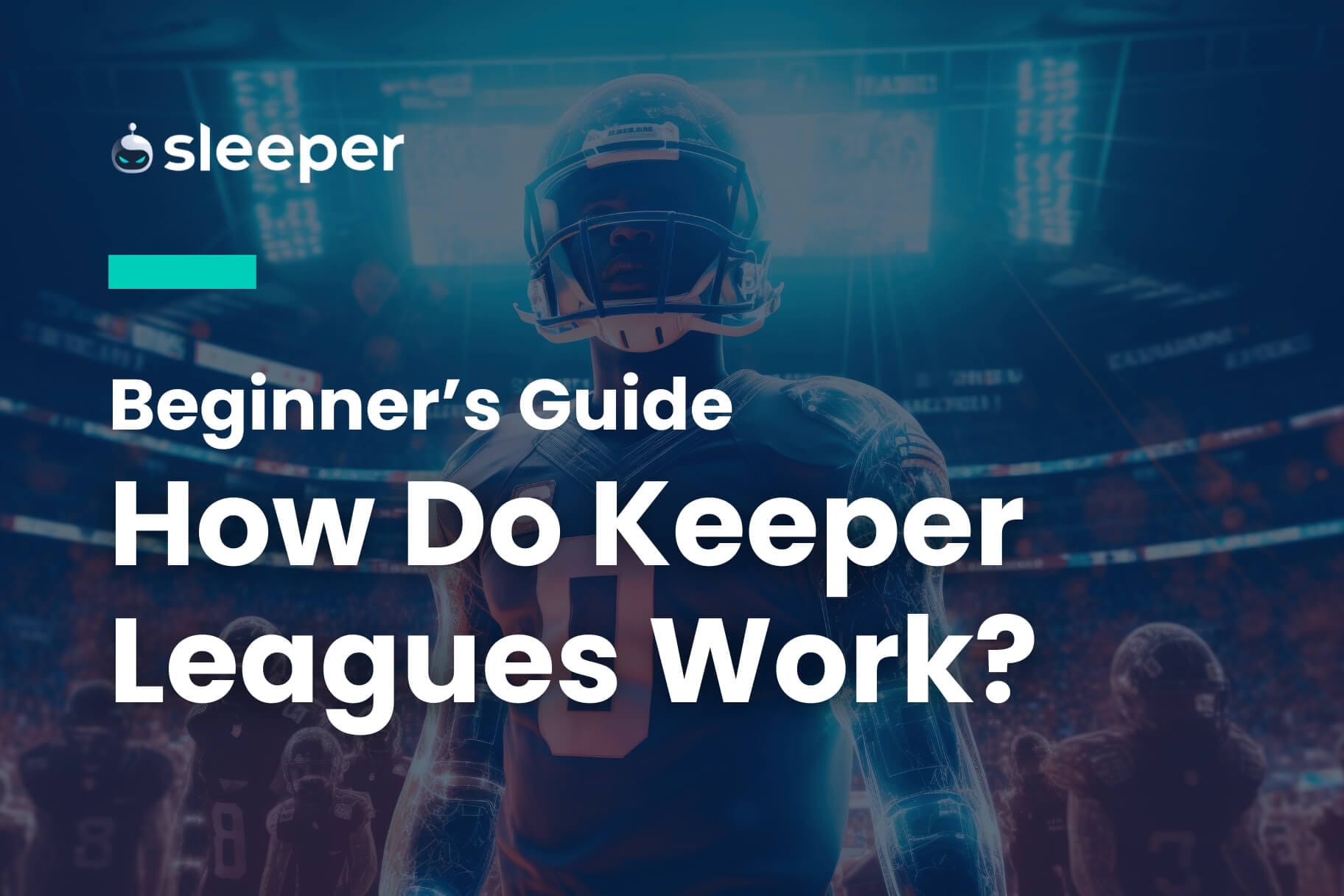A fantasy football keeper league offers multi-year strategy and added value for finding breakout young players. Learn all about this format that blends the best of redraft and dynasty leagues.

Keeper leagues blend the best parts of redraft and dynasty leagues together. So, if you have experience in either of those fantasy football formats, you’re more than ready to take on this new challenge. Keeper fantasy football leagues are growing in popularity, and after reading this short article you’ll have all the tools you need to find success in this emerging format.
What is a Keeper League in Fantasy Football?
A keeper league functions similarly to a redraft league, with the added twist of keeping a fixed amount of players on your team from season to season. With keeper leagues, fantasy managers gain multi-year benefits for their successful draft picks, while still avoiding significant penalties for their bad ones.
NFL, college football, and DFS enthusiasts (Sleeper Picks, anyone?) keep tabs on younger players — not just veterans — and keeper leagues reward those efforts. Generally, the most successful leagues involve 10, 12 or 14 teams with three to five keepers per team. Below, we’ll outline the most common types of keeper leagues.
Prior Season Draft Position Keeper League
In this league type, your keepers cost you their draft position from the prior season. If you drafted Puka Nacua in Round 14 last year, you would forfeit your Round 14 pick for the upcoming season to keep him. This is the most popular keeper league format, where smart fantasy managers get rewarded for drafting young, breakout players.
For multi-year keepers, a penalty is usually applied. For example, if Nacua is kept for a third season, it will likely cost the manager more than a Round 14 pick, depending on how your league is set up. Setting clear keeper rules is critical, which we’ll explain in more detail later on.
Current Season ADP Keeper League
Here your keepers cost you their ADP for the upcoming season. To keep Puka Nacua, you now need to forfeit your first round pick, since he’s projected to go at the tail end of Round 1 in 2024 fantasy drafts. This format is less popular because fantasy managers get very little benefit for successful drafting in the prior season.
No-Cost Keeper League
In this type of league, each team selects their keepers in the offseason, and then all un-kept players are put back into a standard fantasy football snake draft. In a league with three keepers and 15 roster positions, the annual draft would be 12 rounds. No-cost keeper leagues create the highest potential for someone to build a stacked fantasy lineup.
Salary Cap Keeper League
Often considered the most strategically sophisticated type of fantasy football league, a salary cap keeper league (sometimes called a contract league) gives each fantasy manager a maximum budget, or salary cap, that they must stay under at all times. Keepers are maintained by contracts, meaning to keep a player on your roster for multiple seasons you must pay a salary, which increases yearly. Salary cap leagues introduce a significant amount of strategy to navigate league rules, build a competitive personnel roster and remain under budget.
How Do Keeper Leagues Work?

Keeper fantasy football leagues operate identically to a traditional redraft league in the inaugural season. Each subsequent year, however, keeper league managers need to decide which players to keep from the prior season’s roster. This creates both a sense of continuity from the previous season, as well as an incentive to draft or pick up high upside players with superstar potential.
Before a fantasy keeper league begins, all managers need to determine how many players are kept after the season, along with which type of keeper format (listed above) to employ. In year two onward, there will still be an annual draft, but the draft will now be missing several key players (“keepers”). So in a 12-team league with three keepers, there would be 36 players missing from the annual fantasy football redraft process.
The Rules of a Keeper League
The following are some common rules found in most keeper leagues. Ultimately, the rules will depend on league customization, which varies greatly. For example, Sleeper Fantasy Football leagues are known to offer some of the most customizable options of any fantasy platform.
Keeper Eligibility
Keepers need to be on your fantasy roster at the end of the season. Once the fantasy season ends, no players remaining on the waiver wire can be kept. It goes without saying that you cannot poach any players from an opposing manager’s roster.
Number of Keepers
Fantasy managers (or the commissioner) should determine how many players are kept each season. This number typically ranges from two to five and needs to stay consistent from year to year. The amount of keepers allowed is a maximum, meaning a manager can opt to keep fewer than the number or none at all.
Number of Years
Your league will need to decide how many years in a row a player can be kept. This generally ranges from two seasons all the way up to a player’s entire career. When keeping a player for more than two seasons, your league should determine the round penalty (if there is one) before the draft. The most common format for Prior Season Draft Position Keeper Leagues is to increase the round after the second year.
Letting a fantasy manager keep Puka Nacua for his entire career at a Round 14 price tag is probably too generous. Perhaps any player kept for multiple seasons costs a Round 2 or Round 3 pick. The beauty of keeper leagues? You set the rules in a way that allows all managers to have the most fun.
Trading Players and Future Picks
Keeper league managers can trade players during the fantasy season just like traditional redraft leagues. However, future picks can only be traded in a keeper league.
Because keeper leagues by definition last multiple seasons, managers have the option to trade future draft picks.
A fantasy manager that wants to win in 2024 could trade their 2025 first round pick for a veteran player offering immediate production. The team receiving the 2025 first round pick probably won’t compete for a championship in 2024, but they’ll now have a huge advantage for the next fantasy season.
Keeper leagues will have a mix of managers competing for the current season or the next one, so trade strategy is more complex than in a redraft league.
Draft Order
A random draft order should be chosen for the inaugural season. A common rule for subsequent drafts is giving priority to the worst teams from the prior season. Oftentimes, reverse standings order is used, where the last place team gets to pick first the next year, while the winning team gets the last pick in next year’s draft.
Salary cap draft tactics can also be added here. The last place team would get the most money to spend in the offseason draft, while the winning team would get the least. For example, in a salary cap keeper league with a $200 budget, the last place team may have a full $200 to spend the next year. Meanwhile the winning team’s budget may get reduced to only $125.
Keeper League Strategy
While most strategies for redraft leagues carry over to the keeper format, there are a few additional nuances to consider. With proper keeper league strategy, you can build a juggernaut of a fantasy team, year after year.
Selecting Your Keepers
First and foremost, it’s important to keep your best players. If you can keep a stud running back for a second round pick, that’s far better than giving up a 12th rounder to keep a middling wide receiver. The other managers in your league are unlikely to let star players return to the draft pool, so most of the high-end talent in the annual draft will consist of rookies. Most fantasy leagues are won by a team with several high-performing players, rather than a large collection of solid but unspectacular ones.
Once you’ve made sure to lock up your best players, then you can turn to players whose value has risen during the offseason. Keeping a Round 3 talent that cost you a Round 7 pick is better than keeping a Round 3 talent that cost you a Round 3 pick.
To summarize, focus on keeping players with a top-three round ADP in that upcoming season. Then, adjust your focus to surplus value and keep players who go multiple rounds earlier than they did the year prior.
Win Now or Later
It obviously feels great to win your keeper league. But, it’s important to know when to cut bait with your current squad. If your team is 2-5 after seven weeks, trading an aging — but productive — veteran for a future draft pick may be the optimal move. Conversely, a 6-3 team that just lost a star running back to injury may want to trade a future pick for a running back replacement.
Self-awareness is key here, and evaluating how your roster stacks up to your opponents is a worthwhile exercise. Don’t go all-in if you know four or five teams are clearly better than yours at that present moment.
Waiver Wire
You’ll need to determine the keeper value of waiver wire pickups, and most leagues will value waiver pickups as a later round pick. Work the waiver wire just like you would in a redraft league for the majority of the fantasy season. However, late in the year, it’s a good idea to start thinking about the upcoming season if possible.
For example, Raiders RB Zamir White was a waiver wire player who became a big 2024 offseason winner when the team chose not to re-sign starting tailback Josh Jacobs. You would generate surplus value for your team by keeping a player like White in exchange for a late round 2024 pick.
See also: Fantasy Football Scoring Systems
Keeper League Frequently Asked Questions
How many years of experience do I need before joining a keeper fantasy league?
Because keeper fantasy leagues are so similar to season-long fantasy leagues, they are a great format to experiment with after one or two redraft seasons are under your belt.
How is a keeper league different from a regular league?
The main difference is the ability to keep players from one season to the next. You’ll still have a snake draft each year, though every teams’ keepers will be removed from that draft pool.
Is a keeper league a snake draft?
Yes, keeper leagues usually have an annual snake draft, just like a redraft league. Occasionally, you’ll find keeper league variations where an auction draft is substituted for a snake draft, but this is rare.
Who should I draft early in a keeper league?
Target young players and incoming rookies with high redraft ADPs. For example, for the 2024 season players like Marvin Harrison Jr., Bijan Robinson and Ja’Marr Chase are smart targets. Older veterans like Davante Adams, Derrick Henry and Cooper Kupp will carry less value in a keeper league, since their ADP will decline year after year.
Are You Ready to Join a Keeper League?
Now, it’s time to play in a keeper fantasy league. If you’re looking for a free and easy way to set up a keeper league with full customization, download the Sleeper app. Set up your league in less than 30 seconds with the preset settings, or tinker with everything from the number of keepers to choosing between an annual snake or auction draft.
Experienced fantasy football players are also encouraged to check out Sleeper Picks, a daily fantasy game that’s a perfect complement to your season-long leagues.




